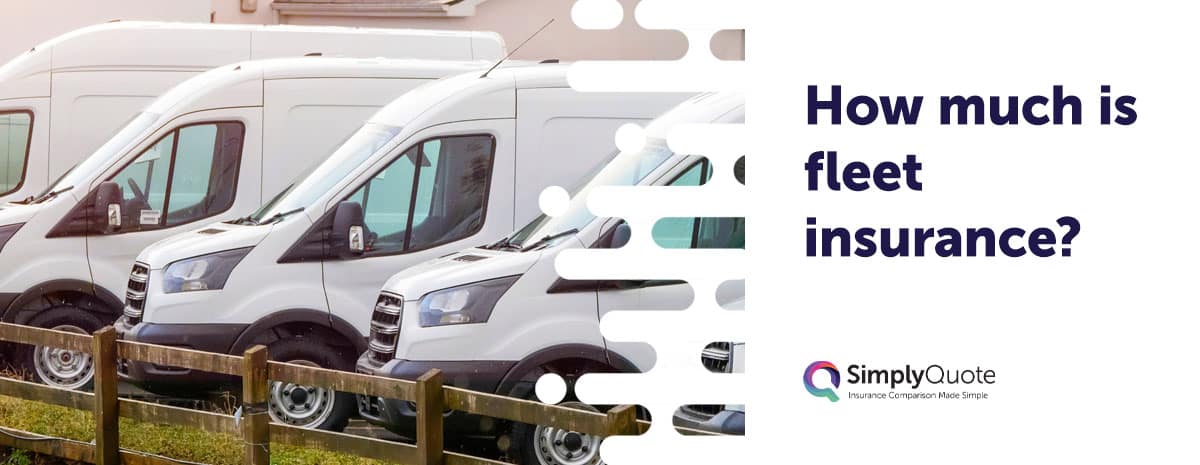How much is fleet insurance?
Fleet insurance in the UK typically costs between £500 and £1,200 per vehicle annually, but prices vary based on fleet size, vehicle type, and risk factors. Insurers assess these elements differently, so two businesses with similar fleets may pay very different premiums.
For businesses looking for monthly costs, fleet insurance can range from £40 to £100 per vehicle per month, depending on coverage level and risk profile. A company operating low-mileage cars will often pay less than a fleet of vans or taxis, which face higher accident risks and insurance claims.
Some fleets pay over £1,000 per vehicle, while others negotiate lower rates with strong risk management strategies.
In this guide, we’ll break down what factors affect fleet insurance pricing, how costs vary by vehicle type, and the best ways to reduce your premiums. We’ll also compare fleet insurance vs. individual policies and explain how businesses can secure the best deals.

What factors affect fleet insurance prices?
Fleet insurance prices depend on several key factors, including fleet size, vehicle type, driver history, and risk level.
Insurers assess these elements to calculate premiums, meaning businesses with similar fleets can pay very different rates based on their risk profile.
Key factors that impact fleet insurance costs
- Fleet Size & Vehicle Type – Larger fleets may get bulk discounts, but higher-value or specialist vehicles (such as taxis or HGVs) generally increase costs.
- Driver Age & Experience – Fleets with younger or less experienced drivers usually face higher premiums due to increased accident risk.
- Claims History & Risk Profile – A poor claims record leads to higher premiums, while businesses with a low-claims history may secure better deals.
- Business Type & Vehicle Usage – Taxis, couriers, and high-mileage fleets face higher risks, leading to increased insurance costs compared to low-mileage company cars.
- Security Measures – Insurers lower premiums for businesses using GPS tracking, immobilisers, CCTV, and secure overnight parking.
- Telematics & Driver Monitoring – Fleets that use telematics to track speed, braking, and driver behaviour may access discounted premiums.
The best way to reduce costs is by maintaining a clean claims history, investing in risk management, and working with a fleet insurance broker to find the best policy.
Looking for fleet insurance? Get your quote today!
Get QuotesHow much is fleet insurance for different fleet types?
Fleet insurance costs vary by vehicle type, with taxis and HGVs generally being more expensive than company cars or vans.
The risk profile, mileage, and purpose of the fleet all impact pricing, meaning businesses should compare policies to find the best deal.
Estimated fleet insurance costs by vehicle type
| Fleet Type | Estimated Cost Per Vehicle (Annual) | Factors Affecting Price |
|---|---|---|
| Car Fleet Insurance | £500 – £1,200 | Low-mileage company cars cost less; high-mileage sales teams may pay more. |
| Van Fleet Insurance | £700 – £1,500 | Couriers and tradespeople with high daily mileage tend to have higher premiums. |
| Taxi Fleet Insurance | £1,500 – £3,000 | Higher risk due to passenger transport and frequent urban driving. |
| HGV Fleet Insurance | £2,000 – £5,000 | Long-haul trucking fleets face increased accident risks and repair costs. |
For businesses managing a mix of vehicles, insurers will assess the overall fleet risk rather than just individual vehicle types. Using telematics, securing vehicles properly, and improving driver safety can help lower premiums across all fleet categories.
How to reduce the cost of fleet insurance?
Businesses can lower their fleet insurance costs by improving driver safety, using telematics, and securing vehicles against theft.
Insurers reward fleets with strong risk management strategies, leading to lower premiums.
7 proven ways to lower fleet insurance costs
- Use Telematics & Driver Monitoring – Installing GPS trackers and telematics helps insurers assess risk and lower premiums for safe fleets.
- Improve Driver Training – Businesses with structured training programs for employees can reduce claims and qualify for discounts.
- Increase Security Measures – Secure overnight parking, immobilisers, and CCTV reduce the risk of theft and vandalism, lowering insurance costs.
- Raise the Voluntary Excess – Opting for a higher excess lowers premiums, though businesses should ensure they can afford it in case of a claim.
- Choose the Right Policy Type – Some fleets benefit from named driver policies over any driver coverage, which is typically more expensive.
- Regularly Review & Compare Policies – Fleet insurance rates change, so businesses should compare quotes annually to ensure they’re getting the best deal.
- Work With a Fleet Insurance Broker – Brokers have access to exclusive deals and discounts that businesses may not find on their own.
By implementing better driver management, risk reduction, and strategic policy choices, businesses can significantly lower their fleet insurance costs while maintaining full coverage.
How does fleet insurance compare to individual policies?
Fleet insurance is often more cost-effective and easier to manage than insuring vehicles individually, especially for businesses with multiple vehicles.
Instead of handling separate policies for each vehicle, a single fleet policy covers all company cars, vans, or taxis under one agreement.
Fleet Insurance vs. Individual Policies
| Factor | Fleet Insurance | Individual Policies |
|---|---|---|
| Cost Efficiency | Typically cheaper per vehicle | More expensive for multiple vehicles |
| Administration | One policy for all vehicles | Separate policies for each vehicle |
| Flexibility | Covers different vehicle types in one policy | Each vehicle needs a specific policy |
| Driver Coverage | Named driver or any driver options | Typically covers a single named driver |
| Renewal & Payments | Single renewal date, easier budgeting | Multiple renewal dates to track |
For businesses with three or more vehicles, fleet insurance simplifies policy management, reduces paperwork, and often lowers overall costs. However, for businesses with just one or two vehicles, individual policies may still be the better option.
Final thoughts
Fleet insurance provides businesses with a cost-effective and streamlined way to insure multiple vehicles under a single policy. Whether managing company cars, vans, taxis, or HGVs, having the right coverage ensures financial protection, simplifies policy management, and can help lower long-term costs through bulk discounts and risk management incentives.
By implementing driver monitoring, security measures, and proactive fleet management, businesses can reduce premiums and improve fleet safety. Since fleet insurance rates vary, companies should compare policies regularly, work with a broker, and explore discounts to secure the best deal.
With insurance costs rising, now is the time for businesses to review their fleet insurance strategy, optimise their risk management, and ensure their vehicles are fully protected at the best possible price.
Frequently Asked Questions (FAQs)
Yes, mini fleet insurance is available for businesses with two or more vehicles, though insurers may have different minimum requirements.
Some policies include leased or rental vehicles, but this depends on the insurer and policy terms. Always check before adding temporary vehicles.
Yes, but younger drivers increase insurance costs due to higher risk. Some insurers may require additional security measures or higher excesses.
Most insurers allow businesses to add or remove vehicles at any time, but policy terms and pricing adjustments may apply.
Fleet insurance can cover vehicles operating from different locations, but insurers may adjust pricing based on regional risk factors and mileage variations.
Policies vary, but most fleet policies are for business use only. Some may offer limited personal use if specified in the policy.
Some fleet insurance policies offer optional breakdown cover, while others require businesses to arrange it separately.
It depends on the insurer, but most fleet policies can be arranged within 24–48 hours, especially with a broker’s help.
